Royal Standard of Spain

- For other monarchs' standards, see Royal Standard.
The Royal Standard of Spain (Estandarte Real or Estandarte del Rey) is the official flag of the King of Spain. It comprises a crimson square, traditional colour of both Castilian and Spanish monarchs, with the coat of arms of the King in the center. It is raised over the official royal residence in Madrid, the Palacio de la Zarzuela and other Spanish royal sites, when the monarch is in residence and displayed on his official car as small flag. It was adopted when Felipe VI was enthroned as King of Spain on 19 June 2014. The Royal Standard is regulated by Rule 2 of Royal Decree 527/2014, 20 June, an amendment to Title II of Spanish Royal Decree 1511/1977 adopting Flags, Standards, Guidons, Insignia and Emblems Regulation.[1]
The Royal Guidon
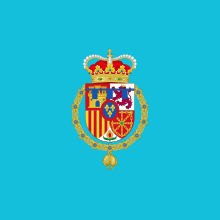
the Princess of Asturias
The Royal Guidon (Guión), the military personal ensign, was also adopted on 19 June 2014, It is described by Rule 1 of Royal Decree 527/2014, an amendment to Title II, Rule 1 of Spanish Royal Decree 1511/1977.[1]
It is similar to the Royal Standard except the Royal Guidon has a gold surround. It is made of silk’s taffeta and measures 80 x 80 cm in size. It is the personal command sign or positional flag of the monarch and traditionally was carried with him. The proportions of the coat of arms are smaller than on the standard.[2]
The Standard and the Guidon of the Princess of Asturias
The Standard of the Princess of Asturias (Estandarte de la Princesa de Asturias) is regulated by Royal Decree 979/2015, an amendment to Title II of Spanish Royal Decree 1511/1977.[3]
The Princess' Standard comprises a light blue (the colour of the Flag of Asturias) square flag displaying the coat of arms of the Prince of Asturias in the center. The Guidon, her military ensign has a gold surround.
Historical standards, guidons and banners of arms of Spanish monarchs
- The Banner is the ceremonial ensign of the monarch and the Royal Standard or Royal Flag is his ensign for public use.
- From Philip II's reign the Royal Guidon was the same as the Royal Standard or Royal Flag with a cross of Burgundy and gold surround.
| The Banners of Arms | ||
| Banner of Arms | Dates | Details |
|---|---|---|
  | 1475–1506 | The banner of arms of the Catholic Monarchs, Isabella I of Castile and Ferdinand II of Aragon, whose marriage unified Spain, were on a crimson background:[4]
Quarterly, 1 and 4. quarterly Castile-León, 2 and 3. per pale Aragon and Argon-Sicily. After the 1492 Conquest of Granada, the kingdom was represented in the Royal Arms by the addition enté en point of Granada's arms. The heraldic banner has long been used by the Catholic Monarchs as their military ensign. |
 | 1518–1556 | In 1504, Archduke Philip the Handsome (King of Castile and Leon by marriage with Joanna) immediately staked his claim to her inheritance by quartering his own arms with those of the Catholic Monarchs, the Spanish quarters were given precedence over his. Hence the arrangement became, quarterly: 1. and 4. grand quarters, quarterly: A. and D. quarterly Castile-León, B. and C. per pale Aragon-Sicily, the grand quarter enté en point for Granada; 2. and 3. grand quarters, quarterly Austria, Burgundy ancient, Burgundy modern, Brabant, with an escutcheon per pale Flanders and Tyrol. In 1518 their son Charles I of Spain (Charles V as Holy Roman Emperor) adopted a banner of arms that comprised these arms on a crimson background. The arms were crowned with the old royal crown (an open crown). After his election as Holy Roman Emperor in 1519 Charles used more often the imperial banner: A shield with his own arms surmounting a black double-headed eagle on a golden background.[5] |
 | 1580–1668 | During the reign of King Phillip II the arms of the Spanish Monarchy become fixed for the remainder of the House of Austria. Originally Philip II used the simplified arms as devised for his father, namely per fess with the Spanish quarters in chief and the Austrian quarters in base.
After the dynastic union with Portugal in 1580, the arms of the Monarchy became per fess, in chief per pale, A. quarterly Castile and Leon, B. per pale Aragon and Aragon-Sicily, the whole enté en point Granada and with an escutcheon of Portugal on the honor point; in base quarterly Austria, Burgundy ancient, Burgundy modern and Brabant, with an escutcheon (in the nombril point) per pale Flanders and Tyrol. |
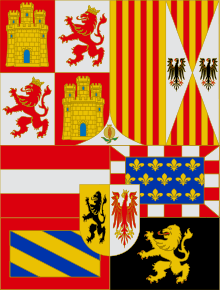 | 1668–1700 | Even though Portugal and its possessions were lost in 1640, the Spanish kings retained the use of the Portuguese arms as arms of pretence until 1668. |
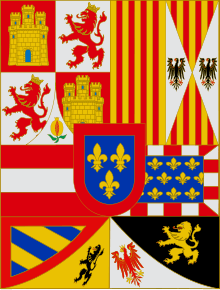 | 1700–1761 | The arms of Bourbon-Anjou were added in 1700 when Phillip V became king of Spain. He introduced changes in the royal arms of Spain. The king's new arms were designed by the French heraldist Clairambault in November 1700, and were as follows:
Per fess: 1. per pale, quarterly Castile and Aragon, enté en point Granada, and per pale, Aragon and Aragon-Sicily; 2. Quarterly, Austria, Burgundy ancient, Burgundy modern and Brabant; enté en point, per pale Flanders and Tyrol. Overall an escutcheon Anjou. |
.svg.png) | 1761–1868 1875–1931 | In 1761 Charles III modified the arms as follows:
Quarterly of six (in three rows of two each): 1. per pale Aragon and Aragon-Sicily; 2. per pale Austria and Burgundy modern; 3. Farnese 4. Medici; 5. Burgundy ancient; 6. Brabant; enté en point per pale Flanders and Tyrol. Overall an escutcheon quarterly of Castile and León enté en point of Granada, overall Anjou. The royal arms were removed by the revolution of 1868. When the Bourbons were restored with Alfonso XII, a decree (Jan 8, 1875) recovered the coat of arms (and the banner of arms) as it stood until September 29, 1868 as personal arms. In 1930 Alfonso XIII, substituted the Aragon quarter with Jerusalem. The Spanish Monarch hasn't used a Banner of Arms since April 14, 1931, when the Second Spanish Republic was proclaimed.[6] |
| Royal Standard or Royal Flag | ||
| Standard | Dates | Details |
|---|---|---|
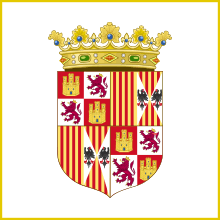 | The common royal banner of the Catholic Monarchs, used until 1492, was an oblong white flag with the arms of Isabella I of Castile and Ferdinand II of Aragon in the center with an open royal crown and without supporters. | |
.svg.png) | The Royal Standard or Royal Flag of the Catholic Monarchs was a white flag with the arms of Isabella I of Castile and Ferdinand II of Aragon in the center with an open royal crown. The Catholic Monarchs's arms were borne by the eagle of Saint John, sable. The Bundle of arrows of Ferdinand II of Aragon and the Yoke of Isabella of Castile where shown as external ornaments. | |
.svg.png) | From 1492 the conquest of Granada was symbolized by the addition enté en point, a Pomegranate, of a quarter for Granada. | |
 | 1668–1700 | The Spanish Monarchs of the House of Habsburg used a crimson flag with the royal arms, crowned with a royal crown with three visible arches and the Order of the Golden Fleece. |
 | After the dynastic union with Portugal in 1580 an escutcheon of Portugal was added on the honor point in the royal arms. | |
 | Philip V introduced in the Royal Standard the changes of the royal arms of Spain with a royal crown with five visible arches. | |
 | In 1761 Charles III modified the royal arms, added the Farnese and Medici arms. | |
 | 1875–1931 | In 1838 the colour of the Royal Standard was modified (crimson to Purpure). |
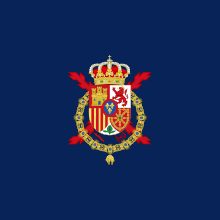 | 2014- (As King Emeritus) | Juan Carlos I used a dark blue background instead of the traditional crimson. The proportions of the coat of arms were reduced. Joined to the shield was the red saltire of Burgundy and, to the dexter and sinister of the base point, the yoke gules in its natural position with ribbons, of the field, and the sheaf of five arrows gules with the arrowheads inverted and ribbons, of the field, which used to be the symbol of the Catholic Monarchs.[7] |
See also
- Coat of arms of the King of Spain
- Coat of arms of the Prince of Asturias
- Heraldic flag
- Spanish monarchy
Footnotes
Sources
- Spanish Royal Decree 1511/1977 (Spanish)
- The flag in the Spanish Armada. Armada Española (Spanish)
- The Royal Standard of Spain. Flags of the World
- The Standard of the Prince of Asturias. Flags of the World
References
- 1 2 "Real Decreto 527/2014, de 20 de junio, por el que se crea el Guión y el Estandarte de Su Majestad el Rey Felipe VI y se modifica el Reglamento de Banderas y Estandartes, Guiones, Insignias y Distintivos, aprobado por Real Decreto 1511/1977, de 21 de enero." [Royal Decree 527/2014 setting up the Guidon and Standard of HM King Felipe VI and amends Standards, Guidons, Insignia and Emblems Regulation, adopted on Royal Decree 1511/1977] (PDF). BOE Spanish Official Journal (in Spanish). 20 June 2014. Retrieved 2014-06-21.
- ↑ "Felipe VI ya cuenta con escudo y guión propios" [Felipe VI has his own coat of arms and guidon]. www.heraldo.es (in Spanish). 2014-06-19. Retrieved 2014-06-20.
- ↑ "BOLETÍN OFICIAL DEL ESTADO" (PDF). Retrieved 31 October 2015.
- ↑ History of Spanish Flag, Spanish Army. (Spanish) Archived April 1, 2009, at the Wayback Machine.
- ↑ The Standard of Charles I of Spain, Cervantesvirtual.com (Cervantes Virtual Library) (Spanish)
- ↑ The Royal Banner 1761- 1868, 1874–1931 (Flags of the World)
- ↑ "Felipe VI ya cuenta con escudo y guión propios" [Felipe VI has his own coat of arms and guindon]. www.heraldo.es (in Spanish). 2014-06-19. Retrieved 2014-06-20.